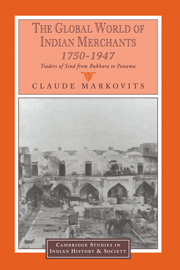Book contents
- Frontmatter
- Contents
- List of maps
- List of tables
- Acknowledgements
- Glossary
- Introduction
- 1 South Asian merchant networks
- 2 The regional context: Sind economy and society, c. 1750–1950
- 3 The Gate of Khorrassan: the Shikarpuri network, c. 1750–1947
- 4 From Kobe to Panama: the Sindworkies of Hyderabad
- 5 Patterns of circulation and business organization in two merchant networks
- 6 The business of the Sind merchants
- 7 The politics of merchant networks
- 8 Community and gender in two merchant networks
- 9 Epilogue: the Sindhi diaspora after 1947
- Conclusion
- Appendices
- Bibliography
- Index
3 - The Gate of Khorrassan: the Shikarpuri network, c. 1750–1947
Published online by Cambridge University Press: 22 October 2009
- Frontmatter
- Contents
- List of maps
- List of tables
- Acknowledgements
- Glossary
- Introduction
- 1 South Asian merchant networks
- 2 The regional context: Sind economy and society, c. 1750–1950
- 3 The Gate of Khorrassan: the Shikarpuri network, c. 1750–1947
- 4 From Kobe to Panama: the Sindworkies of Hyderabad
- 5 Patterns of circulation and business organization in two merchant networks
- 6 The business of the Sind merchants
- 7 The politics of merchant networks
- 8 Community and gender in two merchant networks
- 9 Epilogue: the Sindhi diaspora after 1947
- Conclusion
- Appendices
- Bibliography
- Index
Summary
In May 1837, Alexander Burnes, then on a ‘commercial’ mission to Kabul, wrote from Bahawalpur a paper ‘On the Commerce of Shikarpoor and Upper Sinde’, in which he gave a detailed description of the town, its trade and its merchants. He wrote: ‘Shikarpoor is a town of first importance to the Indus trade and it may be said, to that of Asia’, laying the basis for what was to develop into a kind of myth and exercise some influence on British policymakers. Stressing the town's proximity to the Bolan Pass leading to Kandahar, he mentioned that the merchants always spoke of Shikarpoor and Dera Ghazee Khan as ‘the gates of Khorrassan, by which name they here distinguish the kingdom of Cabul’. He estimated the population to be in excess of 30,000, of whom nin-tenths were Hindus, ‘of the Bunya, Lohana and Bhattea (Bhatia) tribes’, of whom more than half were ‘Baba Nanuk Seiks’ (i.e. Nanakshahis or Nanakpanthis, Sahajdari Sikhs). By Bunya, he actually meant Khatri. He did not praise the physical appearance of the town, finding the bazaar ‘without elegance or beauty’ and the houses ‘lofty and comfortable but destitute of elegance’. What most impressed him, undoubtedly, was the extent of the network of the Shikarpuri merchants. He wrote: ‘It will only be necessary to name the towns at which the Shikarpoor merchants have agents to judge of the unlimited influence which they can command.’
- Type
- Chapter
- Information
- The Global World of Indian Merchants, 1750–1947Traders of Sind from Bukhara to Panama, pp. 57 - 109Publisher: Cambridge University PressPrint publication year: 2000



